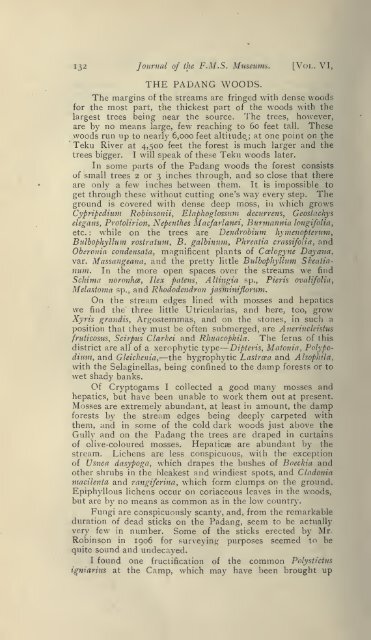Journal of the Federated Malay States museums - Sabrizain.org
Journal of the Federated Malay States museums - Sabrizain.org
Journal of the Federated Malay States museums - Sabrizain.org
You also want an ePaper? Increase the reach of your titles
YUMPU automatically turns print PDFs into web optimized ePapers that Google loves.
* Teku<br />
132 <strong>Journal</strong> <strong>of</strong> <strong>the</strong> F.MS. Museums. [Vol. VI,<br />
THE PADANG WOODS.<br />
The margins <strong>of</strong> <strong>the</strong> streams are fringed with dense woods<br />
for <strong>the</strong> most part, <strong>the</strong> thickest part <strong>of</strong> <strong>the</strong> woods with <strong>the</strong><br />
largest trees being near <strong>the</strong> source. 'Jhe trees, however,<br />
are by no means large, few reaching to 60 feet tall. These<br />
woods run up to nearly 6,000 feet altitude ; at one point on <strong>the</strong><br />
River at 4,500 feet <strong>the</strong> forest is much larger and <strong>the</strong><br />
trees bigger. I will speak <strong>of</strong> <strong>the</strong>se Teku woods later.<br />
In some parts <strong>of</strong> <strong>the</strong> Padang woods <strong>the</strong> forest consists<br />
<strong>of</strong> small trees 2 or 3 inches through, and so close that <strong>the</strong>re<br />
are only a few inches between <strong>the</strong>m. It is impossible to<br />
get through <strong>the</strong>se without cutting one's way every step. The<br />
ground is covered with dense deep moss, in which grows<br />
Cypripediwn Rohinsonii, Elaphoglossuvi decurrens, Geostachys<br />
elegnns, Protoltrion, Nepen<strong>the</strong>s Macfarlanei, Biirmannin longifolia,<br />
etc. : while on <strong>the</strong> trees are Dendrobmm hynienopterum,<br />
Bulbophyllum rostratmn, B. galbinnm, Phreatia crassifolia, and<br />
Obivonia condensata, magnificent plants <strong>of</strong> Coelogyne Dayana,<br />
var. Massangeana, and <strong>the</strong> pretty little Bulbophyllum Skeaiia-<br />
nuvi. In <strong>the</strong> more open spaces over <strong>the</strong> streams we find<br />
Schitna noronhce, Ilex patens, Altingia sp., Pieris ovalifolia,<br />
Melastoma sp., and Rhododendron jasminiflorum.<br />
On <strong>the</strong> stream edges lined with mosses and hepatics<br />
we find <strong>the</strong> three little Utricularias, and here, too, grow<br />
Xyris grandis, Argostemmas, and on <strong>the</strong> stones, in such a<br />
position that <strong>the</strong>y must be <strong>of</strong>ten submerged, are Anerincleistus<br />
fruticosus, Scirpus Clarkei and Rhnacophila. The ferns <strong>of</strong> this<br />
district are all <strong>of</strong> a xerophytic type Dipteris, Matonia, Polypodium,<br />
and Gleichenia,—<strong>the</strong> hygrophytic Lastrcea and Alsophila,<br />
with <strong>the</strong> Selaginellas, being confined to <strong>the</strong> damp forests or to<br />
wet shady banks.<br />
Of Cryptogams I collected a good many mosses and<br />
hepatics, but have been unable to work <strong>the</strong>m out at present.<br />
Mosses are extremely abundant, at least in amount, <strong>the</strong> damp<br />
forests by <strong>the</strong> stream edges being deeply carpeted with<br />
<strong>the</strong>m, and in some <strong>of</strong> <strong>the</strong> cold dark woods just above <strong>the</strong><br />
Gully and on <strong>the</strong> Padang <strong>the</strong> trees are draped in curtains<br />
<strong>of</strong> olive-coloured mosses. Hepaticae are abundant by <strong>the</strong><br />
stream. Lichens are less conspicuous, with <strong>the</strong> exception<br />
<strong>of</strong> Usnea dasypoga, which drapes <strong>the</strong> bushes <strong>of</strong> Boeckia and<br />
o<strong>the</strong>r shrubs in <strong>the</strong> bleakest and windiest spots, and Cladonia<br />
macilenta and rangiferina, which form clumps on <strong>the</strong> ground.<br />
Epiphyllous lichens occur on coriaceous leaves in <strong>the</strong> woods,<br />
but are bj' no means as common as in <strong>the</strong> low country.<br />
Fungi are conspicuously scanty, and, from <strong>the</strong> remarkable<br />
duration <strong>of</strong> dead sticks on <strong>the</strong> Padang, seem to be actually<br />
very few in number. Some <strong>of</strong> <strong>the</strong> sticks erected by Mr.<br />
Robinson in 1906 for surveying purposes seemed to be<br />
quite sound and undecayed.<br />
I found one fructification <strong>of</strong> <strong>the</strong> common Polystictus<br />
i^niarius at <strong>the</strong> Camp, which may have been brought up

















